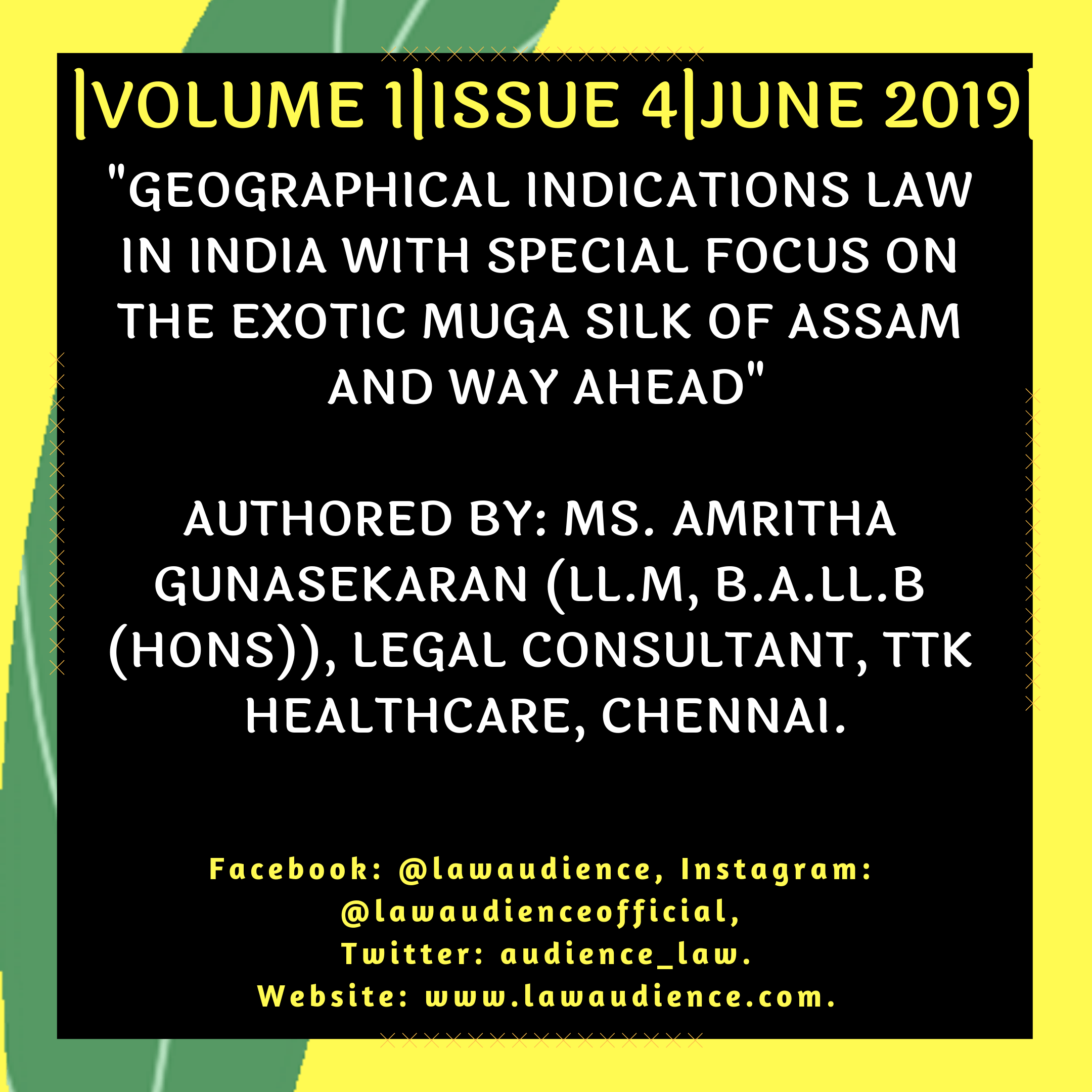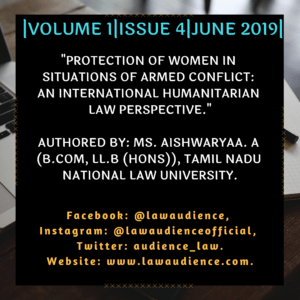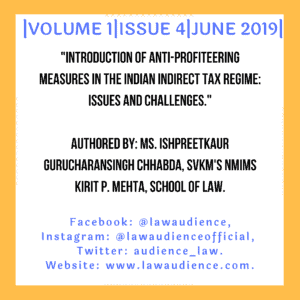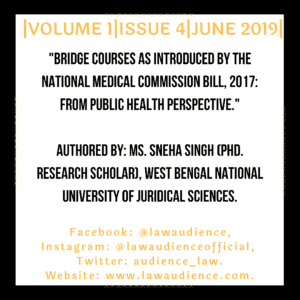Authored By: Ms. Amritha Gunasekaran (LL.M, (B.A.LL.B (Hons)), Legal Consultant, TTK HealthCare, Chennai,
I. ABSTRACT:
“With the announcement of the 1977 Industrial Policy Statement, the development of cottage and small-scale industries became important. In India, although the nature of the state was transferred to a minimal state after 1990, the forces of democracy forced the state to be an integrative state that gave importance to both public welfare and market needs. Due to globalization, the various populist state measures in the Muga sector and increasing awareness and competitiveness of Muga farmers gave the Muga silk industry a new lifeline. But the industry is still not free of challenges. Therefore, the State’s responsibility for improved productivity and posterity of Assam’s Muga silk industry continues to increase.”
Keywords: Geographical Indications, Muga Silk, TRIPS Agreement, WTO, IPR, Assam.
II. INTRODUCTION:
Over the years, protection of Geographical Indication (GI) has emerged as one of the most contentious issues related to IPR (Intellectual Property Rights) in the WTO Agreement on Trade-Related Aspects of Intellectual Property Rights (TRIPS). GI is considered to be one of the oldest forms of IPR’s, first mentioned in the 1883 Paris Convention.[1] The period after the Paris Convention[2] saw numerous efforts aimed at increasing the level of multilateral protection afforded to indications of source and appellations of origin, leading, among other things, to the adoption of the Madrid Agreement for the Repression of False or Deceptive Indications of Source on Goods of 1891, and the Lisbon Agreement for the Protection of Appellations of Origin and their International Registration of 1958 (Lisbon Agreement)[3], and to the inclusion, in the TRIPS Agreement, of a special section on GIs.[4]
India enacted its GI laws to establish national intellectual property laws in accordance with India’s TRIPS obligations. The legal protection of GI assumes enormous significance given its commercial potential. Without suitable legal protection, the competitors who do not have any legitimate rights on the GI might ride free on its reputation. Such unfair business practices result in loss of revenue for the genuine right-holders of the GI and also mislead consumers. Moreover, these practices may eventually hamper the goodwill and reputation associated with the GI. The registration of GI in India is not mandatory.
However, if it is registered better legal protection will be provided to facilitate an infringement action. Section 20(1) of the GI Act, 1999 states that no person “shall” be entitled to institute any proceeding to prevent or to recover damages for, the infringement of an “unregistered” GI.
III. MUGA SILK AND ASSAMESE IDENTITY:
Silk is a fine, continuous and natural protein fiber from cocoon produced by various insects or larvae. A yarn spun from the cocoon is called “Silk” and some forms of it can be woven into textiles. Four varieties of commonly used silk are available. In 1987, India became the second largest producer and consumer of silk in the world. Mulberry is the most widely used silk, making up about 95% of the world’s silk production.[5] In developed countries, demand for raw silk and silk products is increasing day by day. Muga silkworm (Antherea Assama) is a polyphagous insect that grows abundantly in North East India, especially in the Brahmaputra Valley and the foothills of Naga, Khasi and Garo. Muga is an endemic silk variety to Assam’s state.[6] Production of golden Muga silk is a unique, agro base handloom industry in Assam. It takes about 1000 cocoons to generate 125 grams of Silk and around 1000 grams of Silk is needed for a saree and to make one single saree takes about two months right from rearing the silkworm to the finished product.[7] Muga Silk attires reflect the people’s culture in Assam and their heritage. In products such as saris, mekhalas and chadors, Muga silk is used.
Known to have existed since Ahom Dynasty, (1228-1826) historical evidence says that since the 17th century A.D, silk weaving in Assam has a long tradition and it has also found mention in Kautilya’s Arthashastra.[8] Assam is located between 24° 048 ‘and 27° 009’ North Latitudes and 89°082’and 96° 110′ East Longitudes is famous for the world strongest natural protein yarn Muga silk. 20,000 hectares of land is being used to produce Muga silk. Muga silk’s most distinctive quality is that it can absorb 85.08% of the Sun’s harmful UV ray, which can lead to skin cancer. Muga silk industry received the most flourishing and glorious period from the Ahom Dynasty (1228 AD -1826AD) and it was a part of the social and economic life of the Assamese people. Assam Science Technology and Environment Council (ASTEC) took the registration initiative of Muga silk with the help of a New Delhi-based company called Corporate Law Group. Muga silk is known for its extreme durability and has a natural yellowish-golden tint with a shimmering, glossy texture. This shimmering appearance of silk is due to the triangular prism-like cross-sectional structure of the silk bave, which allows silk cloth to refract incoming light at different angles, thus producing colors.
IV. LAW GOVERNING GI IN INDIA:
GI protection in India is available through a sui generis system operationalized through the Geographical Indications of Goods (Registration & Protection) Act of 1999 (‘GI Act’). The GI Act was followed by the Geographical Indications of Goods (Registration and Protection) Rules of 2002 (‘GI Rules’). Under the GI Act, names that do not denote the name of a country or region or locality may still be considered for registration as long as they relate to a particular geographic area and are used in relation to goods originating in that region.[9] Muga silk received GI status in 2007 under the GI Act and was granted GI logo for the purpose of the trademark in 2014. According to Section 21(1)(b) of the GI Act, it gives the ‘ authorized user ‘ exclusive right to use the geographical indication in relation to the goods for which the geographical indication is registered. The use by anyone other than authorized users of the indication is considered to be infringement under the law. Unless a GI is protected in the country of its origin, there is no requirement under the TRIPS Agreement for other countries to extend reciprocal protection.
V. THE PROCEDURE FOR REGISTRATION OF GI IN INDIA:
An application can be made for registering a GI by an association of persons or producers or any organization or authority representing the interests of the producers of the goods concerned.[10]
The requirements of GI registration[11]:
- How the indication is used to identify the products as a GI.
- The Class of goods;
- The territory;
- The particulars of appearance;
- Particulars of producers;
- An affidavit of how the applicant claim to represent the interest;
- The standard benchmark or other characteristics of the GI;
- The particulars of special characteristics;
- Textual description of the proposed boundary;
- The growth attributes in relation to the G.I. pertinent to the application;
- Certified copies of the map of the territory
- The special human skill involved, if any;
- Number of producers; and
- Particulars of inspection structures, if any, to regulate the use of GI.
Application for registration of a GI should be in the prescribed form (GI-1A to 1D) accompanied by the prescribed fee – Rs.5000/- Per Class (triplicate) in the GI Registry, Intellectual Property Office Building, G.S.T. Road, Guindy, Chennai – 600 032. After the application is accepted for registration, the same is advertised in the GI Journal and within 3 months of such advertisement, any person can file opposition proceedings against the registration. The registrar will forward the copy of opposition to the applicant and within two months, the applicant should lodge a counter statement against the opposition. The application would be abandoned if the applicant fails to file the counter-statement. After this, parties submit evidence in support of their cases. Finally, registrar gives an opportunity to the parties for an oral hearing and the matter gets decided for hearing. The registration certificate is valid for a period of 10 years and it can be renewed from time to time for a further period of 10 years.[12]
VI. THE RECENT CASE STUDIES RELATING TO GI IN INDIA:
VI.I POCHAMPALLY IKAT:
Pochampally Saree received GI in 2004. (Registration No.562).[13] The Government of Andhra Pradesh obtained another GI tag in the year 2017 in respect of Pochampally Ikat[14] (LOGO). Pochampally Saree or Pochampalli Ikat[15] is a saree (handloom fabric cluster) made in the geographical region of Bhoodan Pochampally, Yadadri Bhuvanagiri district, Telangana State, India. It is made of natural materials such as cotton or silk or a combination of both, having traditional geometric patterns designs that are evocative of the diffused diamond or chowka design. The manufacturing method includes tying and dyeing the threads before weaving the fabric in a visualized design. Because of its aesthetic appearance and primitive simplicity, this saree has excellent demand both on the national and foreign market.
VI.II BANAGANAPALLE MANGOES:
Banganapalle is a town in the state of Andhra Pradesh, India and famous for its mangoes and regarded as “King of fruits” (most popular and finest variety). It has received GI status in 2017. (Registration No.241).[16] The fruit’s highlight is that it can maintain its sweetness quality under cold storage quality until three months. The government’s logo features a bright yellow fruit around which the tagline reads “Andhra Pradesh’s Banganappalle Mangoes,” with pictures of a guy and a woman appearing to be farmers. GI Registry stated that, the prominent characteristic of Banganapalle mangoes is that their skin has very light spots, the stone is oblong in shape and has very thin seed with sparse and soft fiber all over’.[17]
VI.III KANDHAMAL HALDI:
Turmeric has been used in Asia for thousands of years and is an important element of Ayurveda, Unani, and traditional Chinese medicine. Kandhamal Haldi (Application No. 610) is a variety of turmeric indigenous to southern Odisha and obtained GI status in 2018. It is locally grown in Odisha’s district of Kandhamal and a prime cash crop cultivated by more than 60,000 tribal families.
It is famous for its healing properties, high curcumin content, (used in Pharma Industries) arresting aroma, high antimicrobial and anti-inflammatory property which is mainly used for an array of cuisines, (due to its unique aroma and colour to food items) cosmetic and medicinal purposes. Compared to other turmeric varieties, Kandhamal Haldi has more oleoresin and volatile oil content. The Kandhamal turmeric leaf is used as a pungent flavour and taste to the dish in Odia cuisine called “Enduri Pitha.”[18]
VI.IV GOBINDOBHOG RICE:
Gobindobhog rice is a native, aromatic, non-basmati premium variety cultivated from Burdwan district of West Bengal and the cultivation is as ancient as 300 years. Burdwan is known as Bengal’s rice bowl. Gobindobhog is a short white aromatic grain with a sweet buttery flavour used for any special occasion or to offer Bhog to the deity. It derived its name from the main ingredient in the preparation of the offerings to Govindajiu, the family deity of the Kolkata Setts. Gobindobhog rice obtained GI status in 2015. (Registration No.562)[19] and the unique characteristic of this rice is that it is cultivated late after the rainy season and therefore not much affected by rains and less susceptible to pests.[20]
VII. INTERNATIONAL PROTECTION FOR GI:
At the international level, the TRIPS Agreement sets minimum standards of protection to be complied by WTO members in their respective national laws. However, with regard to the scope of GI protection under TRIPS, there is a hierarchy issue.[21]
TRIPS Agreement mandates a two-level system of protection irrespective of the product categories; it contains a single, identical definition of all GI;
(i) The basic protection applicable to all GI in general (under Article 22), and
(ii) additional protection applicable only to the GI denominating wines and spirits (under Article 23).[22]
This type of protection is challenging if Article 22 does not provide adequate protection of intellectual property for the benefit of a GI’s genuine right-holders.[23] The indication may be used by a producer not belonging to the geographic region indicated by a GI as long as the true origin of the product is indicated on the label, thus free-riding on its reputation and goodwill. A system of notification and registration of GIs for wines and spirits is clearly given in as a mandate in Article 23 (4) of the TRIPS Agreement and in the Doha Declaration. GI’s by virtue of being an integral part of IPR and TRIPS, it has gained legitimacy. However international standards of protection are yet to be put in place in most of the countries of the world compared to patents, trademarks, copyrights, etc. Looking at the existing norms, several issues are yet to be resolved to achieve harmonization.[24]
VIII. FUTURE OF GI IN INDIA:
At present, states in India are competing to pile up GI tags without understanding the benefit to producers and other stakeholders. There is a tough fight between the states as to which state has the highest number of GI registered products. There is a pitfalls post-registration of GI which is highly trader-centric, focusing primarily on protecting GIs against the misuse of the names by unauthorized users and less of producer-centric which is needed to maintain the quality and reputation of the GI products.[25]
Due to lack of awareness and enough incentives, the premium market is not assured to the producers. Also, the legitimate interests of consumers cannot be ignored providing quality assurance and promoting consumer welfare which is the success of GI regime.[26]
It is wrong and extremely short-sighted to see the registration of a GI product as an end in itself. There is a severe lack of post-registration strategy as lack of advertisements, awareness of the product’s specialty and other brand-building tactics.[27] In India, there are very limited instances of infringement suits filed by GI owners or authorized users. This is because the two major hurdles mentioned are the lack of awareness by enforcement agencies about GI law and the lack of additional protection for products beyond wines and spirits.[28]
IX. CONCLUSION:
In the TRIPS negotiations, India opposed the idea of providing additional protection only to wines and spirits, thus inserting Section 22(2) into its domestic GI legislation providing an opportunity to add products other than wines and spirits to the additional protection list. In the instant case, the textile does not fall under the category of ‘additional protection’ and if an infringement case is filed in the future, the infringement will be difficult for the owners and registered users to prove. This is one of many instances where GI law seems to fail to provide the registered products with adequate protection. Aggressive marketing strategies are needed to highlight the originality of protected indications. Infringement will continue unabashed until the above concerns are taken care of. To deal with these problems, steps have to be taken immediately. It is time for the GI authorities to wake up and take concrete steps to implement the GI law thereby giving producers and other stakeholders an opportunity for socio-economic benefit. To deal with these infringements, owners and registered users must be pro-active.
[1] Bently L & Sherman B, Intellectual Property Law, (Oxford University Press, Chennai, India), 2008, p. 977
[2] Article 1(2) of the Paris Convention, “The protection of industrial property has as its objects patents, utility models, industrial designs, trademarks, service marks, trade names, indications of source or appellations of origin, and the repression of unfair competition.”
[3] Lisbon Agreement for the protection of Appellations of Origin and their International Registration, World Intellectual Property Organisation, http://www.wipo.int/treaties/en/registration/lisbon/(accessed on 17 May 2019).
[4] Geographical Indications, WIPO Intellectual Property Handbook: Policy, Law and Use, 2.689, http://www.wipo. int/edocs/pubdocs/en/intproperty/489/wipo_pub_489.pdf (accessed on 16 May 2019) p.130.
[5] Performance of Sericulture Sector, Note on the performance of Indian Silk Industry & Functioning of Central Silk Board, Bangalore, http://www.ministryoftextiles. gov.in/sites/default/files/note-on-sericulture-June2016.pdf (accessed on 17 May 2019).
[6] Baruah, B. (1985). Study on cooking of Muga cocoon with special reference to mixed cocoon and its effect on fibre properties. Ph.D. Thesis, Assam Agricultural University.Jorhat-13.
[7] Baruah, B.(2015). Processing of Muga silk (Antheraea Assama) its Modern Approach” Silk cultivation in north east India with special reference to Assam.” pp-56
[8] Silk farming on the rise in State, http://www.assamtribune.com/scripts/detailsnew.asp?id=jun2 115/state051 (accessed on 16 May 2019).
[9] Section 1(3)(e) of the GI Act, 1999“geographical indication”, in relation to goods, means an indication which identifies such goods as agricultural goods, natural goods or manufactured goods as originating, or manufactured in the territory of a country, or a region or locality in that territory, where a given quality, reputation or other characteristic of such goods is essentially attributable to its geographical origin and in case where such goods are manufactured goods one of the activities of either the production or of processing or preparation of the goods concerned takes place in such territory, region or locality, as the case may be.
[10] Section 11 of the GI Act, 1999.
[11] “Geographical Indications in the Indian Context: ICRIER Working Paper No 11, September 2003.
[12] Section 18(3) of the GI Act, 1999, The Registrar shall, on application made in the prescribed manner, by the registered proprietor or by the authorised user and within the prescribed period and subject to the payment of the prescribed fee, renew the registration of the geographical indication or authorised user, as the case may be, for a period of ten years from the date of expiration of the original registration or of the last renewal of registration, as the case may be (which date is in this section referred to as the expiration of the last registration.
[13] Pochampally Ikat (Registration No.562), granted by Geographical Indications Registry. (accessed on 04 June 2019).
[14] Pochampally Ikat – Geographical Indication Journey, http://www.aiacaonline.org/pdf/policy-briefs-geographical-indication-pochampally-ikat.pdf (accessed on 16 May 2019).
[15] The term Ikat has its origin in Malay – Indonesian expression “Mangikat” meaning to bind, knot or wind around. Pochampaal Ikat, the technique of resist – dyeing is mostly done with geometrical designs, involves the sequence of tying (or wrapping) and dyeing exposed sections of bundled yarn to get a pre-determined colour scheme prior to weaving. The patterns formed on the yarn are then configured into the woven fabric.
[16] Banaganapalle mangoes (Registration No. 241), granted by Geographical Indications Registry. (accessed on 04 June 2019).
[17] Mango gets Indicated, http://indiatoday.intoday.in/story/gi-tag-for-andhra-pradeshs-banganapalle-mango/1/945186.html (accessed on 06 June 2019).
[18] Odisha’s Kandhamal Haladi gets GI tag, http://www.pragativadi.com/odishas-kandhamal-haladi-gets-gi-tag/ (accessed on 06 June 2019).
[19] Gobindobhog Rice (Registration No.531), granted by Geographical Indications Registry. (accessed on 05 June 2019).
[20] India: Gobindobhog rice gets a Geographical Indication (GI) tag https://www.lexology.com/library/detail.aspx?g=9b2440ea-11ee-4641-b49a-e0b7d94f7d7f (accessed on 06 June 2019).
[21] Berenguer, Geographical Origins in the World, Paper presented at the workshop “Promoting Agricultural Competitiveness through Local Know-How”, Proceedings of the Montpellier Workshop, Washington DC: World Bank Group; Paris: MAAPAR; Montpellier: CIRAD (2004).
[22] An Analysis of Country Submission to the TRIPS Council (1999-2007), UNCTAD/ICTSD Policy Brief No 2, December. O’Connor and Company, Geographical Indications and the Challenges for ACP Countries-A Discussion paper, Brussels: CTA (2005).
[23] TRIPS Agreement, Article 22, Paragraph 1.
[24] Agreement on Trade-Related Aspects of Intellectual Property Rights, 15 April 1994, Marrakech Agreement Establishing the World Trade Organization (WTO), Annex-IC, Legal Instruments results of the Uruguay Round, Vol 1, 33 ILM, 181 (1994)
[25] Press Information Bureau, Ministry of India Govt of Textile, (25-July-2014 17:47 IST) http://pib.nic.in/newsite/PrintRelease.aspx?relid=107515 (accessed on 16 May 2019).
[26] Evans, G & Blakeney, Michael. (2006). The Protection of Geographical Indications after DOHA. Journal of International Economic Law. 9. 575-614. 10.1093/jiel/jgl016.
[27] India’s organic agri exports on upswing, by DGCIS India, https://www.thedollarbusiness.com/news/indias-organic-agri- exports-on-upswing/3509 (accessed on 17 May 2019).
[28] Sylvander B & Allaire G, WP3 Report: Conceptual Synthesis Task 1, Strengthening International Research on Geographical Indications (SINER-GI) Project (2007).



